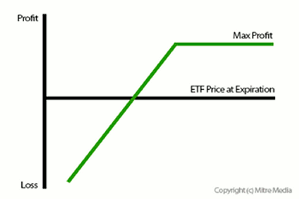This strategy, which offers an alternative to the covered call option, involves a bit more potential upside and downside, writes Justin Kuepper of ETFdb.com.
Exchange-traded funds (ETFs) provide investors with a great way to invest in a wide variety of assets and reach even the most obscure corners of the market. Stock options can help improve upon these strategies by better controlling risks to reward profiles, making them an invaluable tool for any ETF investor. In this article, we’ll take a look at the covered straddle strategy and how it can be used to generate a profit from an existing long position or to enter into a new one.
The covered straddle strategy is very similar to the covered call strategy, which many investors employ to generate income from an existing long position. While the covered call simply involves writing one call option for every 100 shares owned, the covered straddle involves writing one call option and one put option for every 100 shares owned. The resulting “straddle” effectively increases the magnitude compared to the usual covered call strategy.
Who Is the Covered Straddle Strategy Right For?
The covered straddle strategy is considered to be a bullish options strategy, since there’s unlimited downside potential. But by writing a call option, the strategy has limited profit potential, suggesting that investors shouldn’t be overly bullish in the stock. The options themselves gain value over time due to time decay and increase in price with any increase in volatility, but the strategy’s upside is limited to the option strike prices.
Some investors use the strategy as a means to acquire stock, by purchasing only half the amount of stock that they’d eventually like to own. For example, suppose that an investor wants to own 200 shares of SPY; the investor would purchase 100 shares now, enter into the covered straddle, and then wait. At expiration, the investor will either realize a profit and have their 100 shares called away or own the 200 shares for an average price that’s less than the original 100 shares.
What Are the Risks/Rewards?
The covered straddle has a well-defined upside that’s limited to the call option strike price, but unlimited downside due to the long exposure. Unlike covered calls, covered straddles have additional downside associated with writing a put option, guaranteeing someone else the right to sell their stock at a certain price and time. As a result, this naked put means an investor could end up owning 200 shares at the original higher strike price.
NEXT PAGE: Details of the Strategy
|pagebreak|The maximum profit and loss are as follows:
Maximum profitis achieved when the price of the underlying ETF is greater than or equal to the strike price of the written call option. The profit itself is equal to the strike price of the written call option plus net premiums received, minus the purchase price of the underlying stock and any commissions paid to brokerages.
Maximum loss occurs when the price of the underlying ETF is less than the purchase price of the underlying stock, since the investor is left owning not only the original stock at a loss, but an additional 100 shares from the written put option at its strike price.
Breakeven is equal to the purchase price of the underlying ETF, plus the strike price of the written put option, minus the net premiums received, all divided by two.
How to Use a Covered Straddle Strategy
The covered straddle strategy is relatively straightforward to implement, but let’s take a look at a quick example to demonstrate its dynamics. Suppose that you’d like to own 200 shares of SPY by next month, but want to minimize your cash outlay and use a little leverage. So, you decide to purchase 100 shares of SPY at 155.00 and create a covered straddle by writing one at-the-money 155 May ’13 call for $2.77 and one at-the-money 155 May ’13 put for $3.25.
The resulting option diagram looks something like this:
Some potential scenarios would include:

The Bottom Line
Covered straddles offer ETF investors an alternative to the covered call option that involves a bit more potential upside and downside. Many investors utilize covered straddles when looking to enter a stock position, since it provides the added benefit of premiums collected. Simply purchase half of the amount of stock desired, enter into the position, and then you’ll eventually own either the full position at expiration or walk away collecting the premiums.
By Justin Kuepper, Contributor, ETFdb.com






















